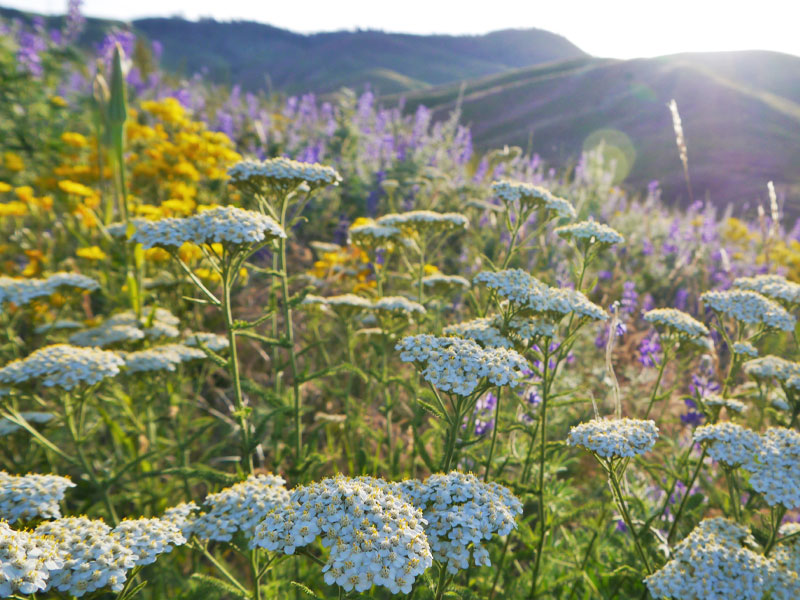Yarrow

Yarrow (achillea millefolium) is an aromatic flowering plant native to temperate regions of the Northern Hemisphere in Asia, Europe, and North America. Yarrow is pest-resistant, drought-resistant (waterwise), attracts butterflies, and is virtually care-free, making it a great choice for borders, ground covers, and open meadows.
It is a vertical perennial that produces one to several stems 2-4 feet in height, and has a spreading rhizomatous growth form. Leaves are evenly distributed along the stem, with the leaves near the middle and bottom of the stem being the largest. The flowers may be white, pink, red, cream, yellow or bicolor pastel. Active growth occurs in the spring and the plant commonly flowers from May to July. Wild yarrow can found in the mildly disturbed soil of grasslands and open forests.
Benefits
Drought Tolerant (waterwise). The benefits of including a drought tolerant plant such as Yarrow in your landscape are many. They include:
- Lower water bills from reduced water use
- Attractive plants with less maintenance
- More wildlife habitat
- Less plant disease and more pest resistance
- Deeper roots help to stabilize slopes
- More groundwater recharge
- Less polluted runoff flowing to the ocean
Conservation Biological Control. In addition to being a drought tolerant plant, Yarrow also attracts predatory or parasitoid insects that prey upon pest insects. This means that by including Yarrow in your garden you are helping maintain and enhance the reproduction, survival, and efficacy of natural enemies (predators, parasitoids, and pathogens) of pests.
The term for this is “Conservation Biological Control” and means that adding Yarrow helps support natural enemies that are important in regulating populations of many agricultural and forest insect pests. Biological control is a component of an integrated pest management strategy. It is defined as the reduction of pest populations by natural enemies and typically involves an active human role.
Planting
Plant in the spring in a sunny, well-drained, average to poor soil and space the plants 1 to 2 feet apart–soil that is rich can trigger aggressive growth. Yarrow thrives in hot, dry conditions and does not tolerate wet soil. They are quick to establish.
Pollination
Yarrow flowers provide nectar and pollen that is especially attractive to butterflies, wasps, flies, and bees. Of special value to native honey bees, Yarrow is one of the top plants that provide a good supply of both sugary nectar and protein-rich pollen sought after by these and other long-tongued bees.
Plant Care
- Add a thin layer of compost, followed by a 2–inch layer of mulch around your plants each spring.
- If you receive less than 1 inch of rain a week in the summer, remember to water your plants regularly.
- Plants tend to be floppy and may require staking.
- If you plant yarrows from tip cuttings, plant them in spring or early summer.
- Deadhead early to promote longer blooming period and prevents seedlings.
- Foliage can be cut to ground mid-spring to produce shorter, stockier stems.
- Divide yarrow plants every 3 to 5 years. Lift the clumps of flowers in early spring or fall and remove any dead stems from the center of the clump. You can replant the divisions in well-prepared soil.
Pest & Diseases
- Aphids
- Powdery mildew
- Grey Mold (botrytis)
- Mealybug
- Rust
